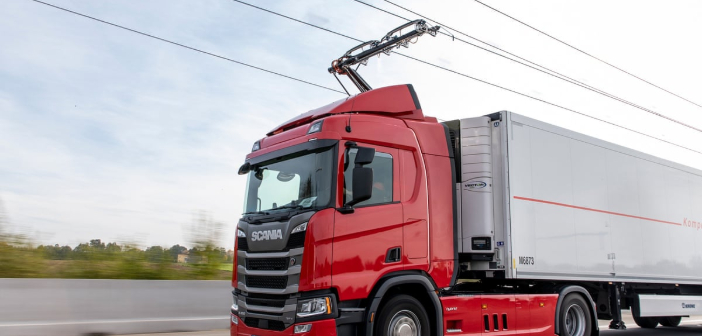Overhead charging cables installed on the strategic road network for electric lorries on ‘e-highways’ could significantly reduce carbon dioxide emissions from road freight, according to a new UK government-funded white paper.
The report, titled ‘Decarbonising the UK’s Long-Haul Road Freight at Minimum Economic Cost‘, by The Centre for Sustainable Road Freight (SRF), stated that overhead catenaries and compatible HGVs are the most energy-efficient and cost-effective solution to fully decarbonise the UK’s road freight network.
“Their deployment is essential if the UK is to achieve its carbon budgets through to net-zero GHG emissions by 2050. The technology is proven and the transition from the current diesel-centric approach to catenary-powered electric vehicles can be handled with hybrid vehicles,” said the report.
The infrastructure investment can also be partly shared with other investments such as motorway service station charging of cars, the 5G network and the intelligent transport system infrastructure needed to support connected and autonomous vehicles of the future, it suggested.
The plan for the ‘electric road system’ would cost £19.3bn and be implemented on all of the network apart from the most remote parts of the UK within reach of the trucks by the late 2030s.
The catenary cables, powered by the national electricity grid, would link to lorries driving in the inside lanes on 4,300 miles (7,000km) of UK roads through an extendable rig known as a pantograph – similar to those on the top of electric trains. The electricity would power the lorry’s electric motor, as well as recharging an onboard electric battery that would power them to their destinations beyond the electrified roads.
The report suggested that a first phase of building work on the busiest roads could take two years, costing £5.6bn. However, electrifying the most popular routes alone would cover almost a third of the miles travelled by HGVs in the UK. Later stages would bring the total cost to £19.3bn.
Investments in the pantograph EVs would pay back the vehicle operators in 18 months (through lower energy costs) and the electrification infrastructure could pay back its investors in 15 years (through electricity sales). “This makes the infrastructure investment a unique opportunity for private finance.
The improved energy efficiency of the freight system will also create sufficient headroom in the economics for substantial government revenues through an electricity excise tax, road user charge or some other form of tax,” said the report.





